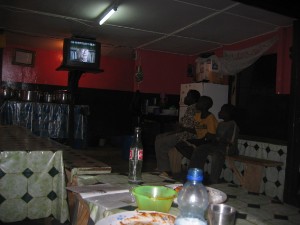|
You may have heard your mother say words on the order of, Finish your food, children are starving in Africa. Well, they are; but Mali turns out to be one of the cultures where you don't finish your food at a meal, because if you do, it insults your host that he didn't feed you enough. Kone assures us that leftover food in Mali gets distributed, it doesn't go into a locked dumpster and get doused with bleach to appease the gods of the Free Market, as it does in Advanced societies.
It turned out that Mohamed was staying at his mother's house tonight, which we only found out cause he wanted to drop Kone off first and then us.
I don't like for Mohamed to be so Japanese. Our little bit of generosity was taking away his time with his mother. Needless to say I would never have asked him out if I had known or if he had said. I must remember: we are work to these guys, not friends; our camaraderie is part of their doing their job and if we genuinely want to be nice instead of egotistical, we let them put down their tools early and go home. Inviting them out is like overtime.









